Timing sensor FIAT MAREA 2000 1.G Workshop Manual
[x] Cancel search | Manufacturer: FIAT, Model Year: 2000, Model line: MAREA, Model: FIAT MAREA 2000 1.GPages: 330
Page 34 of 330
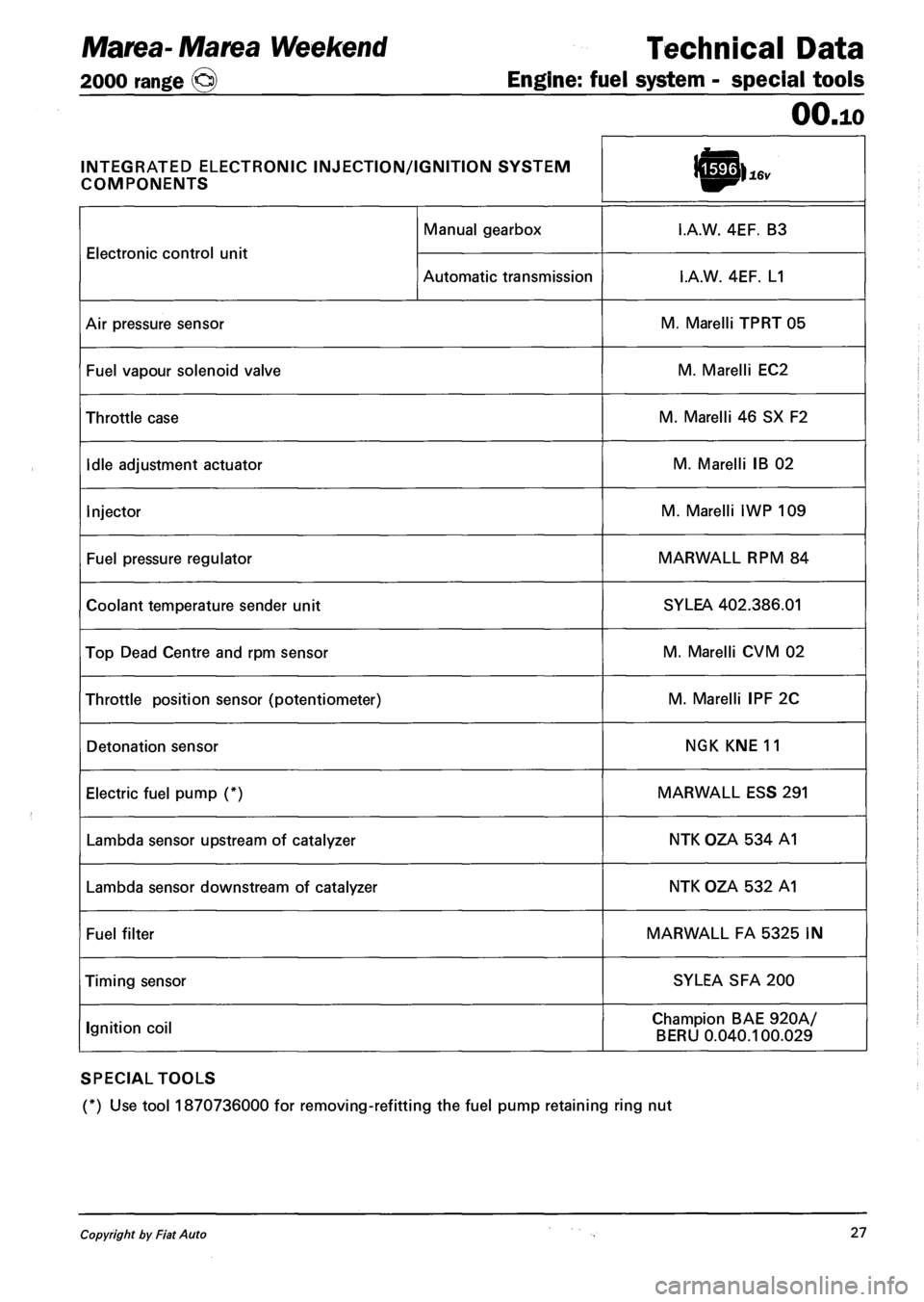
Marea-Marea Weekend Technical Data
2000 range (j§) Engine: fuel system - special tools
OO.io
INTEGRATED ELECTRONIC INJECTION/IGNITION SYSTEM
COMPONENTS
Electronic control unit
Manual gearbox I.A.W. 4EF. B3
Electronic control unit
Automatic transmission I.A.W. 4EF. L1
Air pressure sensor M. Marelli TPRT 05
Fuel vapour solenoid valve M. Marelli EC2
Throttle case M. Marelli 46 SX F2
Idle adjustment actuator M. Marelli IB 02
Injector M. Marelli IWP 109
Fuel pressure regulator MARWALL RPM 84
Coolant temperature sender unit SYLEA 402.386.01
Top Dead Centre and rpm sensor M. Marelli CVM 02
Throttle position sensor (potentiometer) M. Marelli IPF 2C
Detonation sensor NGK KNE 11
Electric fuel pump (*) MARWALL ESS 291
Lambda sensor upstream of catalyzer NTK OZA 534 A1
Lambda sensor downstream of catalyzer NTK OZA 532 A1
Fuel filter MARWALL FA 5325 IN
Timing sensor SYLEA SFA 200
Ignition coil Champion BAE 920A/
BERU 0.040.100.029
SPECIAL TOOLS
(*) Use tool 1870736000 for removing-refitting the fuel pump retaining ring nut
Copyright by Fiat Auto 27
Page 35 of 330
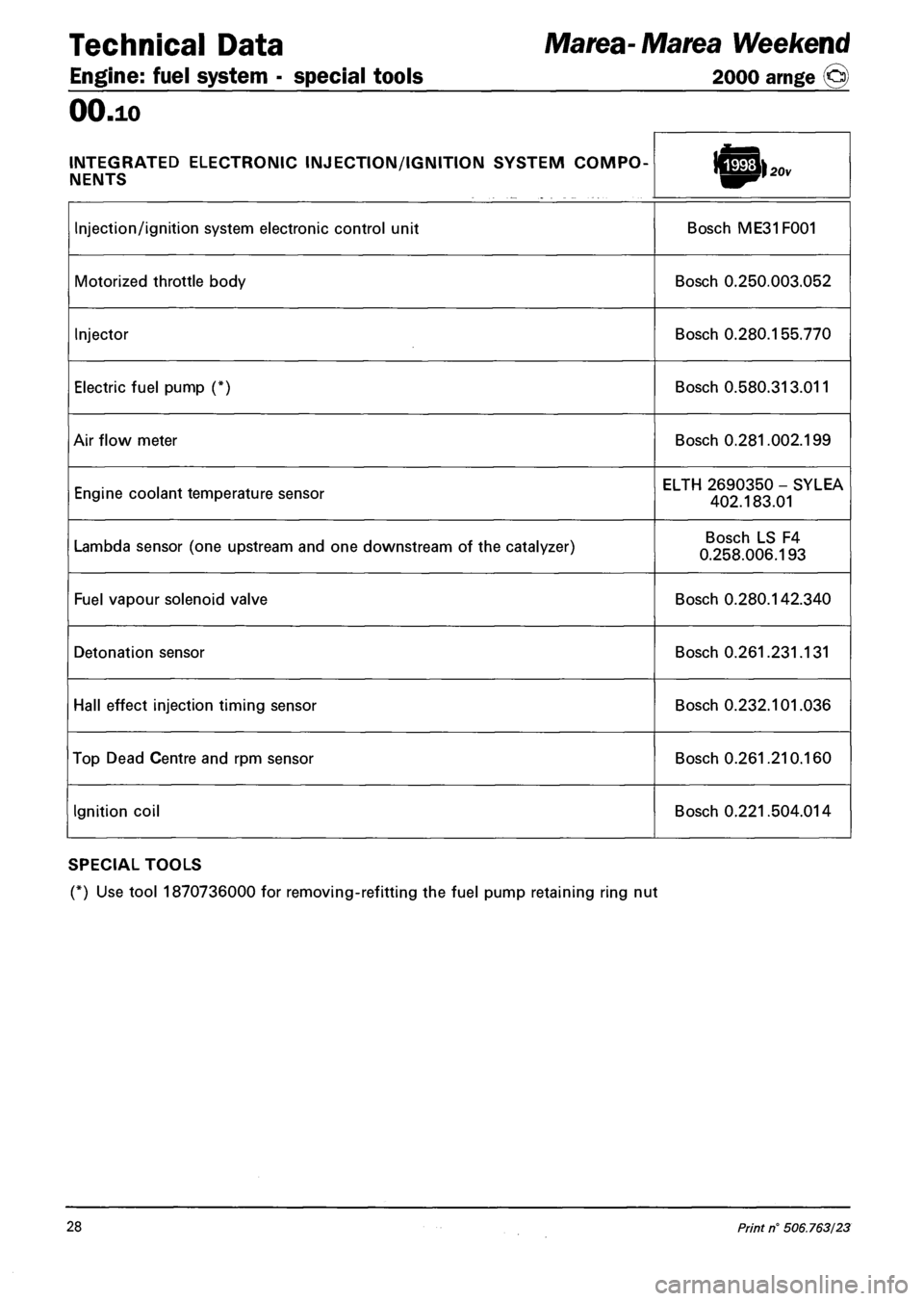
Technical Data Marea- Marea Weekend
Engine: fuel system - special tools 2000 arnge ©)
OO.io
INTEGRATED ELECTRONIC INJECTION/IGNITION SYSTEM COMPO
NENTS
Injection/ignition system electronic control unit Bosch ME31F001
Motorized throttle body Bosch 0.250.003.052
Injector Bosch 0.280.155.770
Electric fuel pump (*) Bosch 0.580.313.011
Air flow meter Bosch 0.281.002.199
Engine coolant temperature sensor ELTH 2690350 - SYLEA
402.183.01
Lambda sensor (one upstream and one downstream of the catalyzer) Bosch LS F4
0.258.006.193
Fuel vapour solenoid valve Bosch 0.280.142.340
Detonation sensor Bosch 0.261.231.131
Hall effect injection timing sensor Bosch 0.232.101.036
Top Dead Centre and rpm sensor Bosch 0.261.210.160
Ignition coil Bosch 0.221.504.014
SPECIAL TOOLS
(*) Use tool 1870736000 for removing-refitting the fuel pump retaining ring nut
28 Print n° 506.763/23
Page 69 of 330
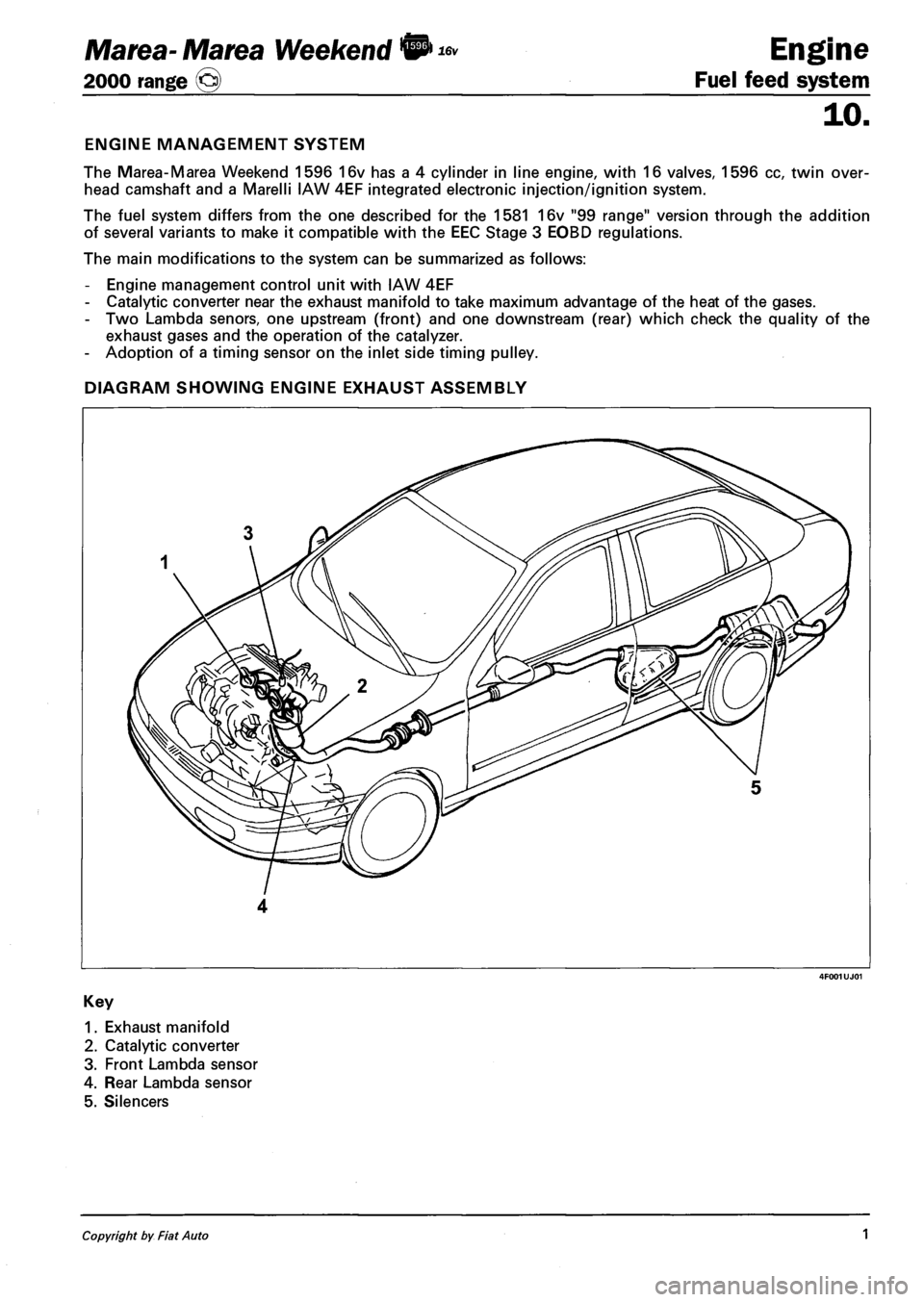
Marea- Marea Weekend • ^ Engine
2000 range (Q) Fuel feed system
10.
ENGINE MANAGEMENT SYSTEM
The Marea-Marea Weekend 1596 16v has a 4 cylinder in line engine, with 16 valves, 1596 cc, twin over
head camshaft and a Marelli IAW 4EF integrated electronic injection/ignition system.
The fuel system differs from the one described for the 1581 16v "99 range" version through the addition
of several variants to make it compatible with the EEC Stage 3 EOBD regulations.
The main modifications to the system can be summarized as follows:
- Engine management control unit with IAW 4EF
- Catalytic converter near the exhaust manifold to take maximum advantage of the heat of the gases.
- Two Lambda senors, one upstream (front) and one downstream (rear) which check the quality of the
exhaust gases and the operation of the catalyzer.
- Adoption of a timing sensor on the inlet side timing pulley.
DIAGRAM SHOWING ENGINE EXHAUST ASSEMBLY
1. Exhaust manifold
2. Catalytic converter
3. Front Lambda sensor
4. Rear Lambda sensor
5. Silencers
Copyright by Fiat Auto 1
Page 71 of 330
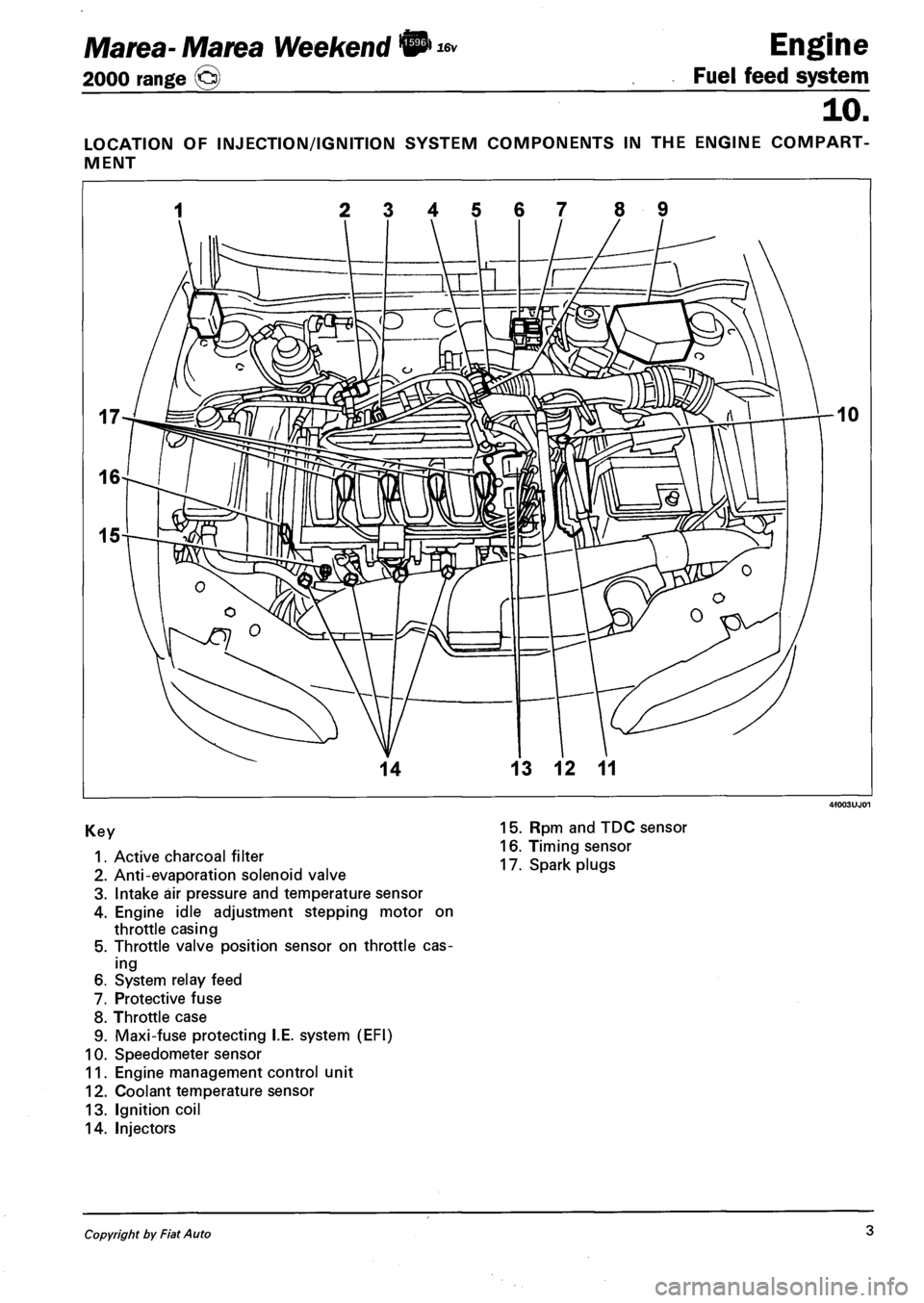
Marea- Marea Weekend 9* Engine
2000 range (Q) Fuel feed system
10.
LOCATION OF INJECTION/IGNITION SYSTEM COMPONENTS IN THE ENGINE COMPART
MENT
1 2345678 9
Key
1. Active charcoal filter
2. Anti-evaporation solenoid valve
3. Intake air pressure and temperature sensor
4. Engine idle adjustment stepping motor on
throttle casing
5. Throttle valve position sensor on throttle cas
ing
6. System relay feed
7. Protective fuse
8. Throttle case
9. Maxi-fuse protecting I.E. system (EFI)
10. Speedometer sensor
11. Engine management control unit
12. Coolant temperature sensor
13. Ignition coil
14. Injectors
15. Rpm and TDC sensor
16. Timing sensor
17. Spark plugs
Copyright by Fiat Auto 3
Page 78 of 330
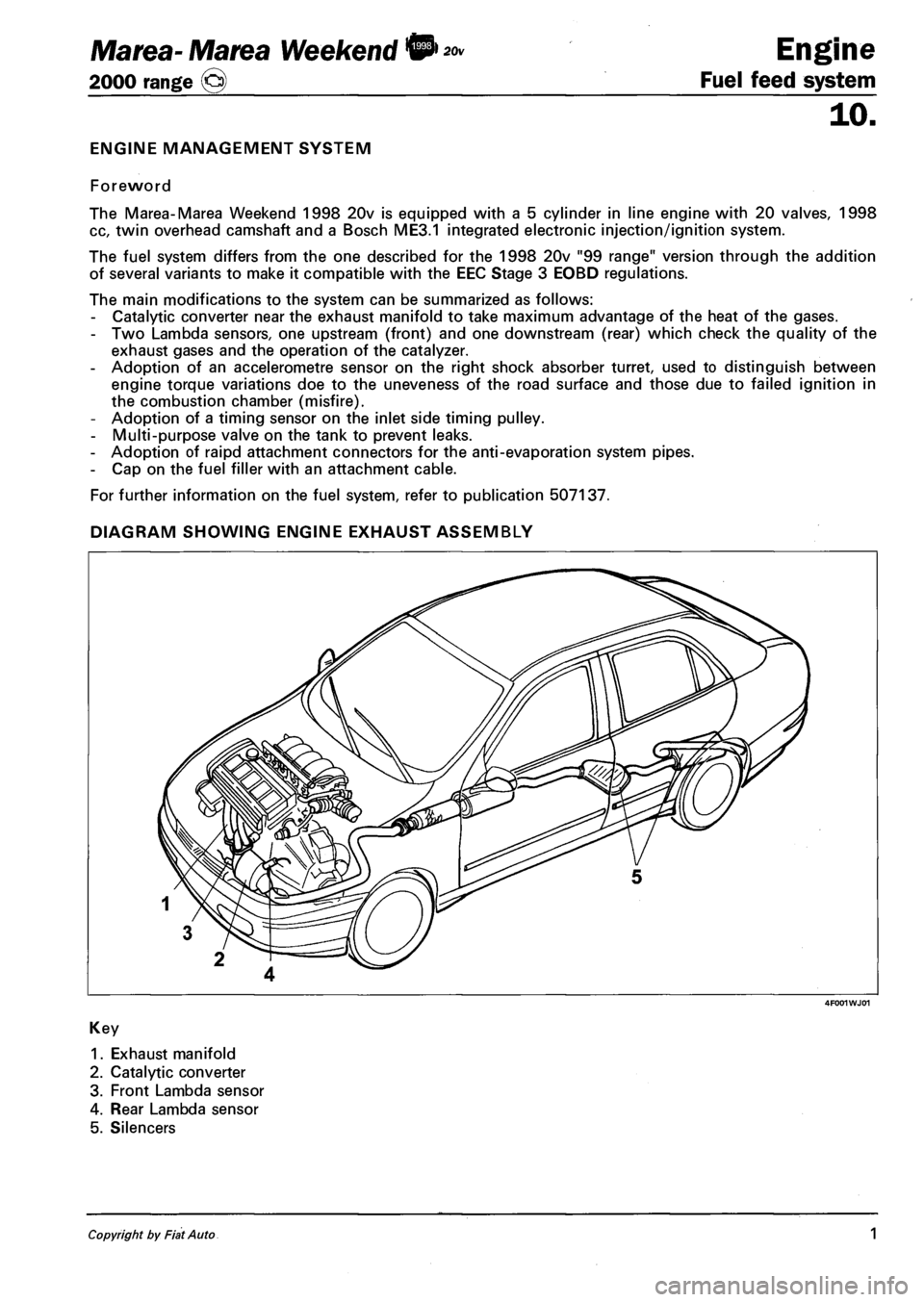
Marea- Marea Weekend & Engine
2000 range (§) Fuel feed system
ENGINE MANAGEMENT SYSTEM
Foreword
The Marea-Marea Weekend 1998 20v is equipped with a 5 cylinder in line engine with 20 valves, 1998
cc, twin overhead camshaft and a Bosch ME3.1 integrated electronic injection/ignition system.
The fuel system differs from the one described for the 1998 20v "99 range" version through the addition
of several variants to make it compatible with the EEC Stage 3 EOBD regulations.
The main modifications to the system can be summarized as follows:
- Catalytic converter near the exhaust manifold to take maximum advantage of the heat of the gases.
- Two Lambda sensors, one upstream (front) and one downstream (rear) which check the quality of the
exhaust gases and the operation of the catalyzer.
- Adoption of an accelerometre sensor on the right shock absorber turret, used to distinguish between
engine torque variations doe to the uneveness of the road surface and those due to failed ignition in
the combustion chamber (misfire).
- Adoption of a timing sensor on the inlet side timing pulley.
- Multi-purpose valve on the tank to prevent leaks.
- Adoption of raipd attachment connectors for the anti-evaporation system pipes.
- Cap on the fuel filler with an attachment cable.
For further information on the fuel system, refer to publication 507137.
DIAGRAM SHOWING ENGINE EXHAUST ASSEMBLY
4F001WJ01
Key
1. Exhaust manifold
2. Catalytic converter
3. Front Lambda sensor
4. Rear Lambda sensor
5. Silencers
Copyright by Fiat Auto 1
Page 79 of 330
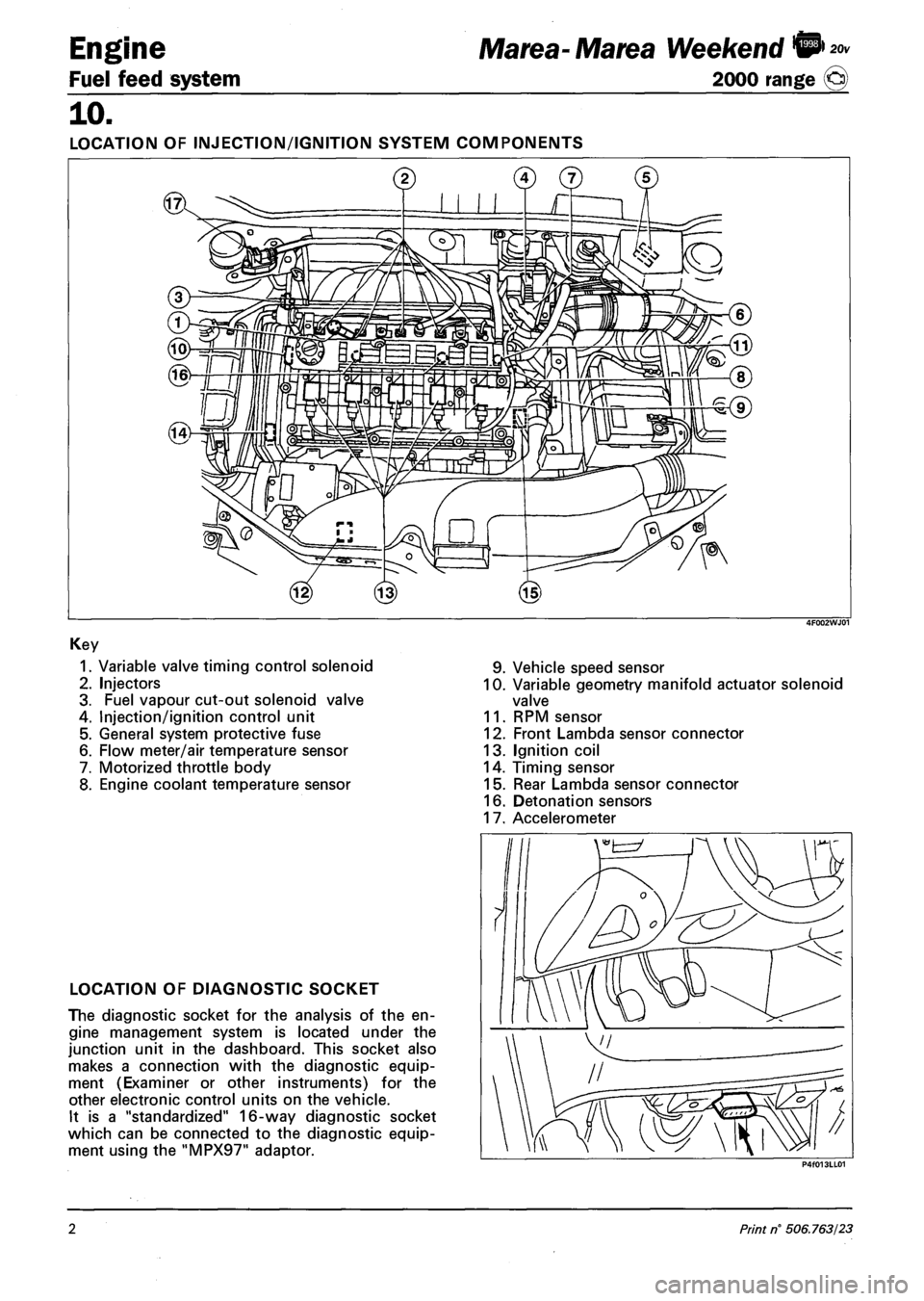
Engine
Fuel feed system
Marea-Marea Weekend ®> *»
2000 range @)
10.
LOCATION OF INJECTION/IGNITION SYSTEM COMPONENTS
Key
1. Variable valve timing control solenoid
2. Injectors
3. Fuel vapour cut-out solenoid valve
4. Injection/ignition control unit
5. General system protective fuse
6. Flow meter/air temperature sensor
7. Motorized throttle body
8. Engine coolant temperature sensor
9. Vehicle speed sensor
10. Variable geometry manifold actuator solenoid
valve
11. RPM sensor
12. Front Lambda sensor connector
13. Ignition coil
14. Timing sensor
15. Rear Lambda sensor connector
16. Detonation sensors
17. Accelerometer
LOCATION OF DIAGNOSTIC SOCKET
The diagnostic socket for the analysis of the en
gine management system is located under the
junction unit in the dashboard. This socket also
makes a connection with the diagnostic equip
ment (Examiner or other instruments) for the
other electronic control units on the vehicle.
It is a "standardized" 16-way diagnostic socket
which can be connected to the diagnostic equip
ment using the "MPX97" adaptor.
2 Print n° 506.763/23
Page 86 of 330
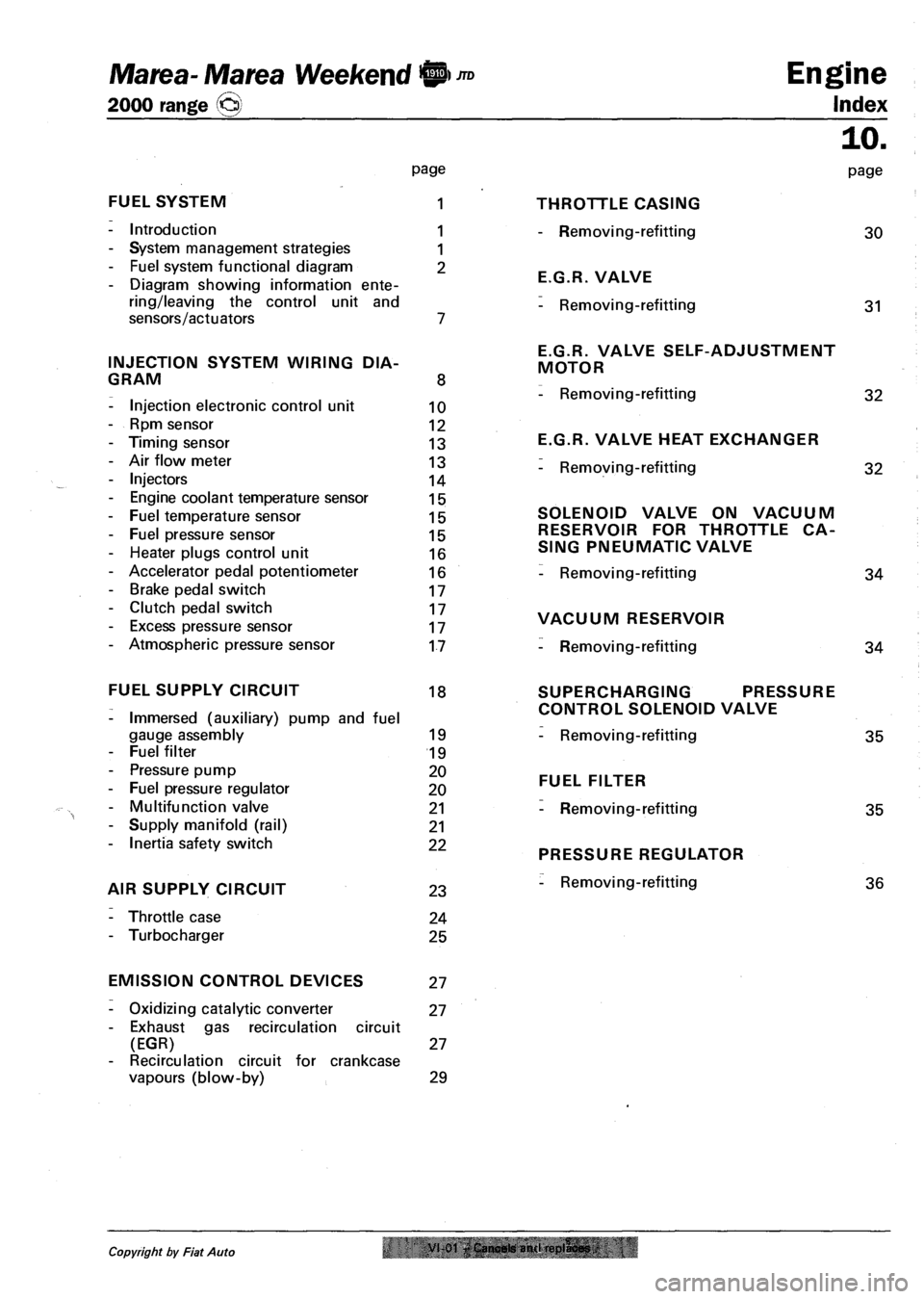
Marea- Marea Weekend 9 \) JTD
2000 range O
Engine
Index
FUEL SYSTEM
- Introduction
- System management strategies
- Fuel system functional diagram
- Diagram showing information ente
ring/leaving the control unit and
sensors/actuators
INJECTION SYSTEM WIRING DIA
GRAM
- Injection electronic control unit
- Rpm sensor
- Timing sensor
- Air flow meter
- Injectors
- Engine coolant temperature sensor
- Fuel temperature sensor
- Fuel pressure sensor
- Heater plugs control unit
- Accelerator pedal potentiometer
- Brake pedal switch
- Clutch pedal switch
- Excess pressure sensor
- Atmospheric pressure sensor
page
1
1
1
2
8
10
12
13
13
14
15
15
15
16
16
17
17
17
17
THROTTLE CASING
- Removing-refitting
E.G.R. VALVE
- Removing-refitting
E.G.R. VALVE SELF-ADJUSTMENT
MOTOR
- Removing-refitting
E.G.R. VALVE HEAT EXCHANGER
- Removing-refitting
SOLENOID VALVE ON VACUUM
RESERVOIR FOR THROTTLE CA
SING PNEUMATIC VALVE
- Removing-refitting
VACUUM RESERVOIR
- Removing-refitting
10.
page
30
31
32
32
34
34
FUEL SUPPLY CIRCUIT 18
- Immersed (auxiliary) pump and fuel
gauge assembly 19
- Fuel filter 19
- Pressure pump 20
- Fuel pressure regulator 20
- Multifunction valve 21
- Supply manifold (rail) 21
- Inertia safety switch 22
AIR SUPPLY CIRCUIT 23
- Throttle case 24
- Turbocharger 25
SUPERCHARGING PRESSURE
CONTROL SOLENOID VALVE
- Removing-refitting 35
FUEL FILTER
- Removing-refitting 35
PRESSURE REGULATOR
- Removing-refitting 36
EMISSION CONTROL DEVICES 27
- Oxidizing catalytic converter 27
- Exhaust gas recirculation circuit
(EGR) 27
- Recirculation circuit for crankcase
vapours (blow-by) 29
Copyright by Fiat Auto VI 01 Cancels anil replaces
Page 87 of 330
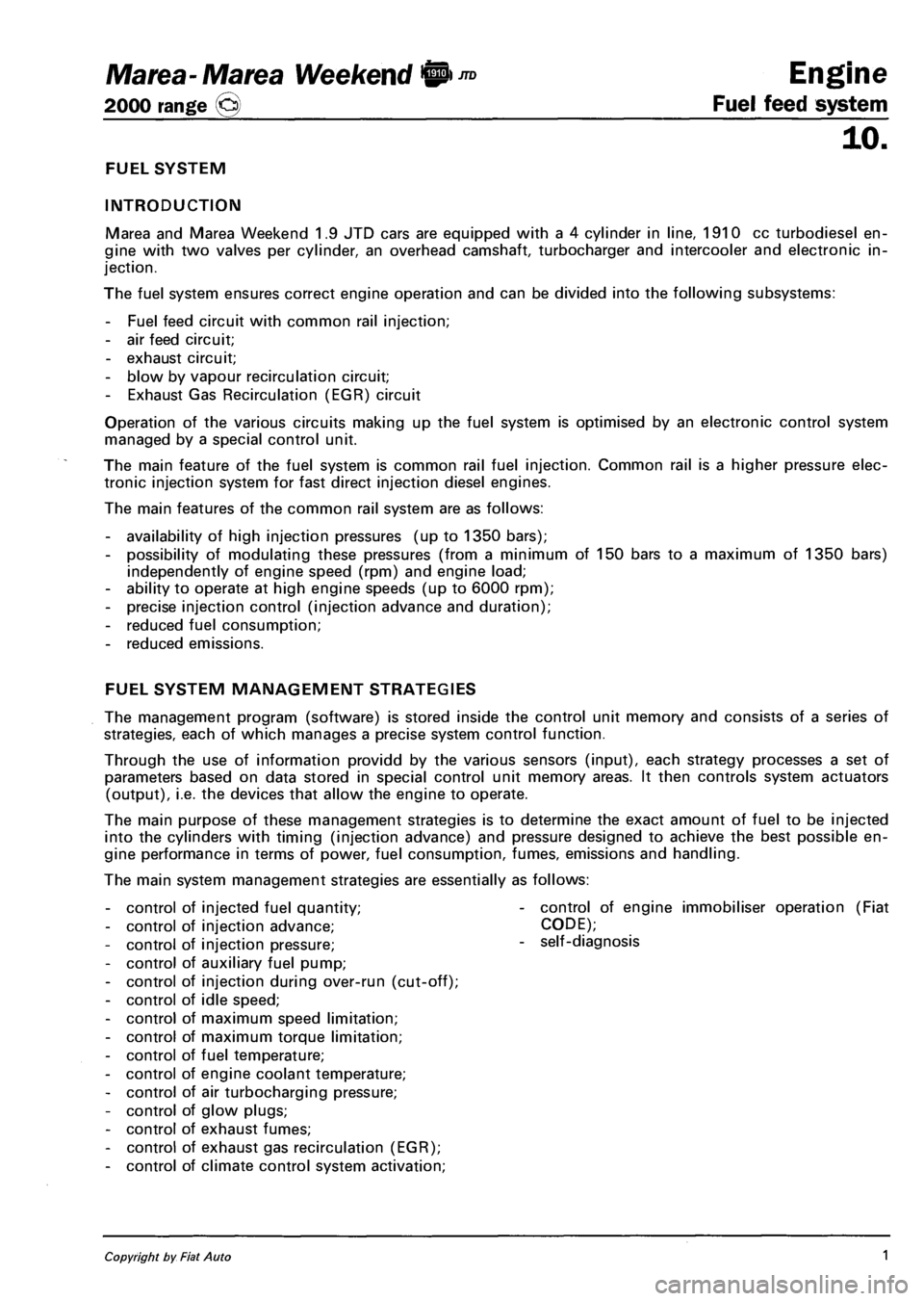
Marea- Marea Weekend © ™ Engine
2000 range Q Fuel feed system
10.
FUEL SYSTEM
INTRODUCTION
Marea and Marea Weekend 1.9 JTD cars are equipped with a 4 cylinder in line, 1910 cc turbodiesel en
gine with two valves per cylinder, an overhead camshaft, turbocharger and intercooler and electronic in
jection.
The fuel system ensures correct engine operation and can be divided into the following subsystems:
- Fuel feed circuit with common rail injection;
- air feed circuit;
- exhaust circuit;
- blow by vapour recirculation circuit;
- Exhaust Gas Recirculation (EGR) circuit
Operation of the various circuits making up the fuel system is optimised by an electronic control system
managed by a special control unit.
The main feature of the fuel system is common rail fuel injection. Common rail is a higher pressure elec
tronic injection system for fast direct injection diesel engines.
The main features of the common rail system are as follows:
- availability of high injection pressures (up to 1350 bars);
- possibility of modulating these pressures (from a minimum of 150 bars to a maximum of 1350 bars)
independently of engine speed (rpm) and engine load;
- ability to operate at high engine speeds (up to 6000 rpm);
- precise injection control (injection advance and duration);
- reduced fuel consumption;
- reduced emissions.
FUEL SYSTEM MANAGEMENT STRATEGIES
The management program (software) is stored inside the control unit memory and consists of a series of
strategies, each of which manages a precise system control function.
Through the use of information providd by the various sensors (input), each strategy processes a set of
parameters based on data stored in special control unit memory areas. It then controls system actuators
(output), i.e. the devices that allow the engine to operate.
The main purpose of these management strategies is to determine the exact amount of fuel to be injected
into the cylinders with timing (injection advance) and pressure designed to achieve the best possible en
gine performance in terms of power, fuel consumption, fumes, emissions and handling.
The main system management strategies are essentially as follows:
contro
contro
contro
contro
contro
contro
contro
contro
contro
contro
contro
contro
contro
contro
contro
of injected fuel quantity;
of injection advance;
of injection pressure;
of auxiliary fuel pump;
of injection during over-run (cut-off);
of idle speed;
of maximum speed limitation;
of maximum torque limitation;
of fuel temperature;
of engine coolant temperature;
of air turbocharging pressure;
of glow plugs;
of exhaust fumes;
of exhaust gas recirculation (EGR);
of climate control system activation;
control of engine immobiliser operation (Fiat
CODE);
self-diagnosis
Copyright by Fiat Auto 1
Page 88 of 330
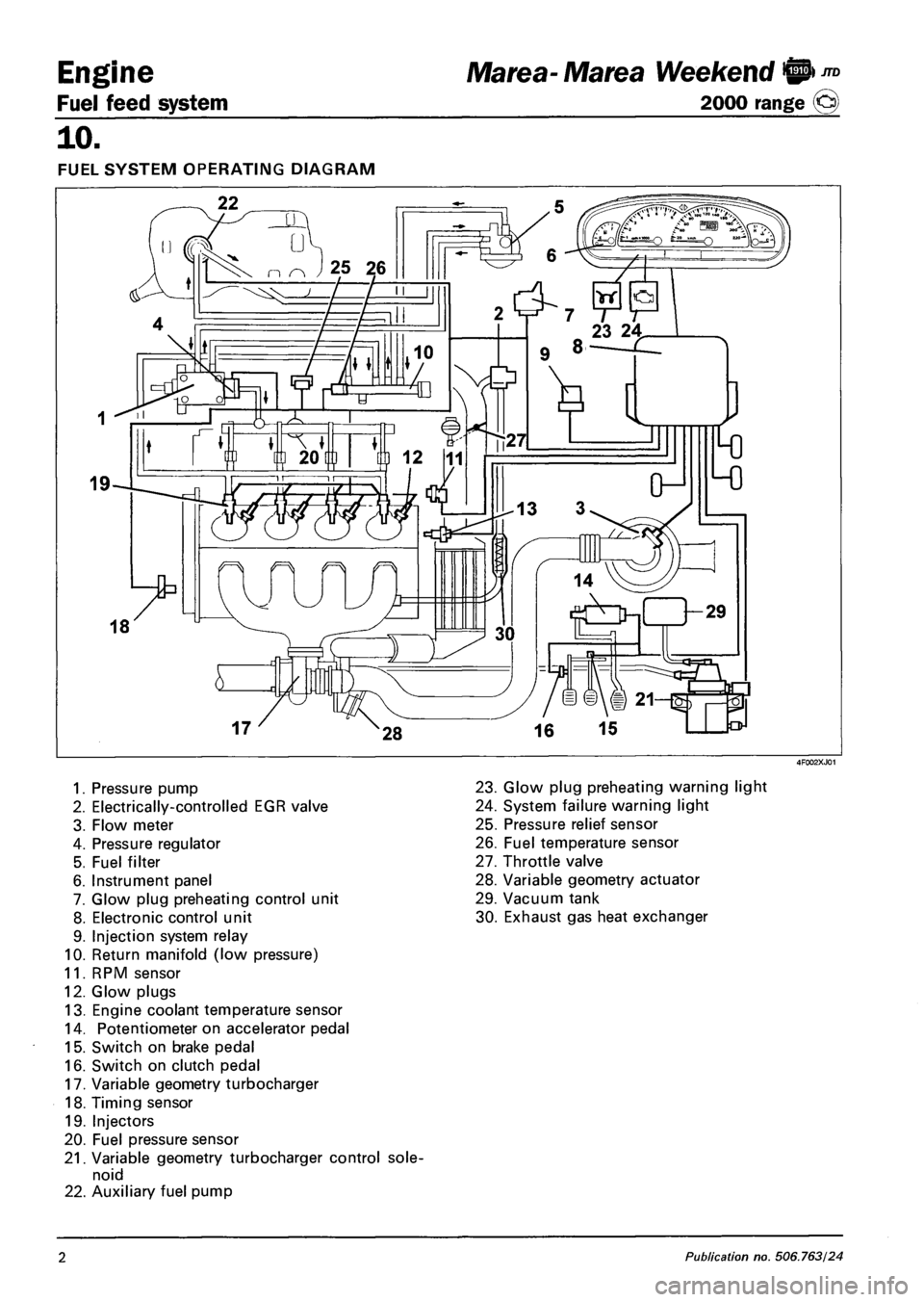
Engine
Fuel feed system
Marea- Marea Weekend © ™
2000 range ©
10.
FUEL SYSTEM OPERATING DIAGRAM
1. Pressure pump
2. Electrically-controlled EGR valve
3. Flow meter
4. Pressure regulator
5. Fuel filter
6. Instrument panel
7. Glow plug preheating control unit
8. Electronic control unit
9. Injection system relay
10. Return manifold (low pressure)
11. RPM sensor
12. Glow plugs
13. Engine coolant temperature sensor
14. Potentiometer on accelerator pedal
15. Switch on brake pedal
16. Switch on clutch pedal
17. Variable geometry turbocharger
18. Timing sensor
19. Injectors
20. Fuel pressure sensor
21. Variable geometry turbocharger control sole
noid
22. Auxiliary fuel pump
23. Glow plug preheating warning light
24. System failure warning light
25. Pressure relief sensor
26. Fuel temperature sensor
27. Throttle valve
28. Variable geometry actuator
29. Vacuum tank
30. Exhaust gas heat exchanger
2 Publication no. 506.763/24
Page 89 of 330
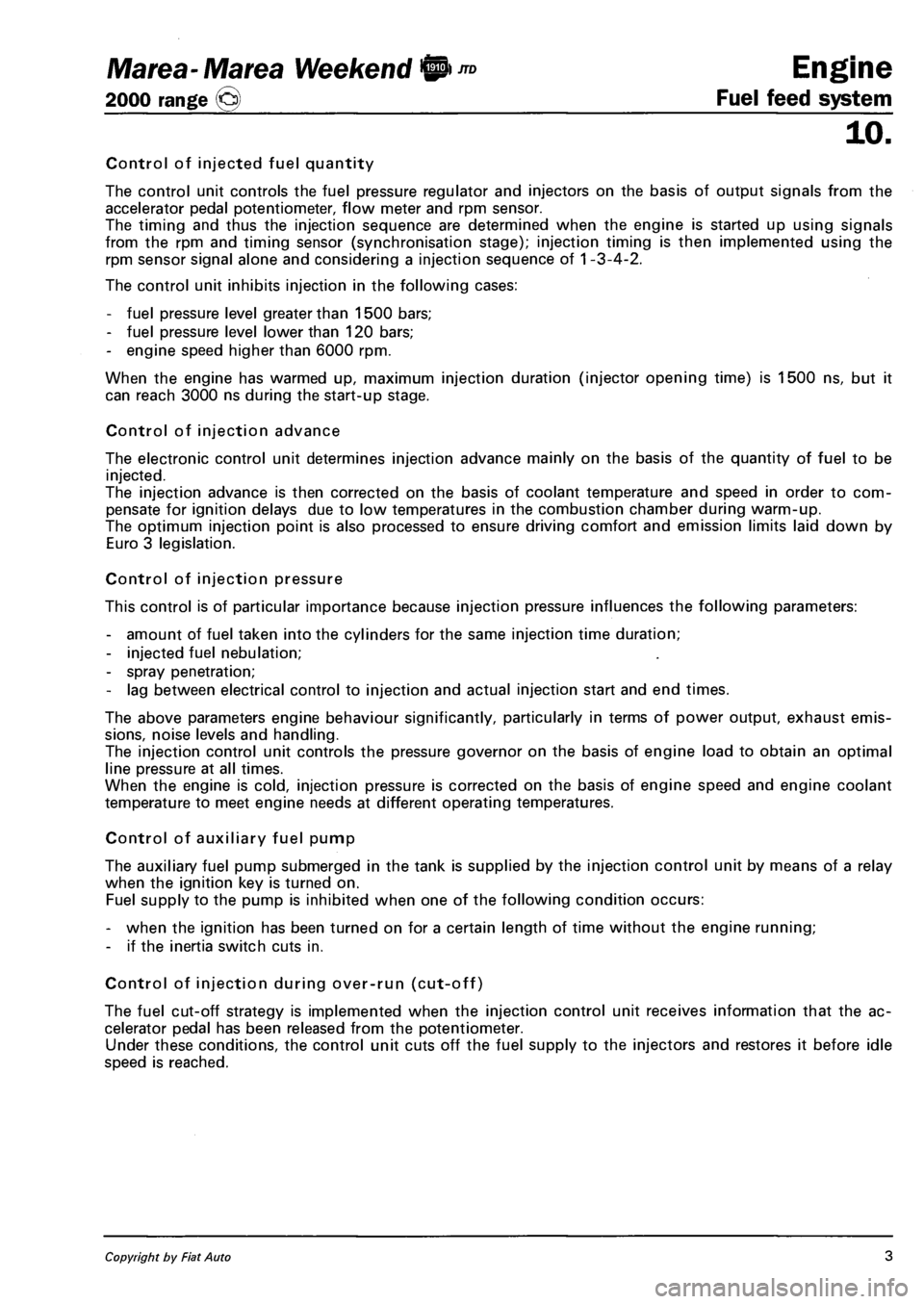
Ma tea- Marea Weekend 9 ™
2000 range (Q) Fuel feed system
Engine
10.
Control of injected fuel quantity
The control unit controls the fuel pressure regulator and injectors on the basis of output signals from the
accelerator pedal potentiometer, flow meter and rpm sensor.
The timing and thus the injection sequence are determined when the engine is started up using signals
from the rpm and timing sensor (synchronisation stage); injection timing is then implemented using the
rpm sensor signal alone and considering a injection sequence of 1 -3-4-2.
The control unit inhibits injection in the following cases:
- fuel pressure level greater than 1500 bars;
- fuel pressure level lower than 120 bars;
- engine speed higher than 6000 rpm.
When the engine has warmed up, maximum injection duration (injector opening time) is 1500 ns, but it
can reach 3000 ns during the start-up stage.
Control of injection advance
The electronic control unit determines injection advance mainly on the basis of the quantity of fuel to be
injected.
The injection advance is then corrected on the basis of coolant temperature and speed in order to com
pensate for ignition delays due to low temperatures in the combustion chamber during warm-up.
The optimum injection point is also processed to ensure driving comfort and emission limits laid down by
Euro 3 legislation.
Control of injection pressure
This control is of particular importance because injection pressure influences the following parameters:
- amount of fuel taken into the cylinders for the same injection time duration;
- injected fuel nebulation;
- spray penetration;
- lag between electrical control to injection and actual injection start and end times.
The above parameters engine behaviour significantly, particularly in terms of power output, exhaust emis
sions, noise levels and handling.
The injection control unit controls the pressure governor on the basis of engine load to obtain an optimal
line pressure at all times.
When the engine is cold, injection pressure is corrected on the basis of engine speed and engine coolant
temperature to meet engine needs at different operating temperatures.
Control of auxiliary fuel pump
The auxiliary fuel pump submerged in the tank is supplied by the injection control unit by means of a relay
when the ignition key is turned on.
Fuel supply to the pump is inhibited when one of the following condition occurs:
- when the ignition has been turned on for a certain length of time without the engine running;
- if the inertia switch cuts in.
Control of injection during over-run (cut-off)
The fuel cut-off strategy is implemented when the injection control unit receives information that the ac
celerator pedal has been released from the potentiometer.
Under these conditions, the control unit cuts off the fuel supply to the injectors and restores it before idle
speed is reached.
Copyright by Fiat Auto 3